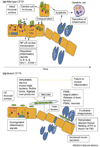Airway epithelial control of Pseudomonas aeruginosa infection in cystic fibrosis
- PMID: 18262467
- PMCID: PMC3697050
- DOI: 10.1016/j.molmed.2008.01.002
Airway epithelial control of Pseudomonas aeruginosa infection in cystic fibrosis
Abstract
Defective expression or function of the cystic fibrosis transmembrane conductance regulator (CFTR) underlies the hypersusceptibility of cystic fibrosis (CF) patients to chronic airway infections, particularly with Pseudomonas aeruginosa. CFTR is involved in the specific recognition of P. aeruginosa, thereby contributing to effective innate immunity and proper hydration of the airway surface layer (ASL). In CF, the airway epithelium fails to initiate an appropriate innate immune response, allowing the microbe to bind to mucus plugs that are then not properly cleared because of the dehydrated ASL. Recent studies have identified numerous CFTR-dependent factors that are recruited to the epithelial plasma membrane in response to infection and that are needed for bacterial clearance, a process that is defective in CF patients hypersusceptible to infection with this organism.
Figures


References
-
- Li Z, et al. Longitudinal development of mucoid Pseudomonas aeruginosa infection and lung disease progression in children with cystic fibrosis. J. Am. Med. Assoc. 2005;293:581–588. - PubMed
-
- Emerson J, et al. Pseudomonas aeruginosa and other predictors of mortality and morbidity in young children with cystic fibrosis. Pediatr. Pulmonol. 2002;34:91–100. - PubMed
-
- Pier GB, et al. Opsonophagocytic killing antibody to Pseudomonas aeruginosa mucoid exopolysaccharide in older, non-colonized cystic fibrosis patients. N. Engl. J. Med. 1987;317:793–798. - PubMed
-
- Baltimore RS, et al. Immunohistopathologic localization of Pseudomonas aeruginosa in lungs from patients with cystic fibrosis -Implications for the pathogenesis of progressive lung deterioration. Am. Rev. Respir. Dis. 1989;140:1650–1661. - PubMed
Publication types
MeSH terms
Substances
Grants and funding
LinkOut - more resources
Full Text Sources
Medical

